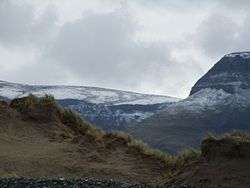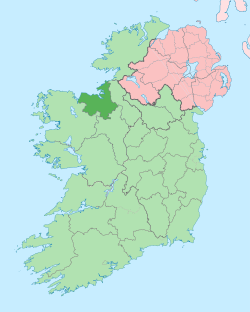Grange, County Sligo
| Grange An Ghráinseach | |
|---|---|
| Village | |
 Grange Location in Ireland | |
| Coordinates: 54°24′00″N 8°31′00″W / 54.4000°N 8.5167°WCoordinates: 54°24′00″N 8°31′00″W / 54.4000°N 8.5167°W | |
| Country | Ireland |
| Province | Connacht |
| County | County Sligo |
| Elevation | 28 m (92 ft) |
| Population (2016)[1] | |
| • Total | 586 |
| Time zone | UTC+0 (WET) |
| • Summer (DST) | UTC-1 (IST (WEST)) |
| Irish Grid Reference | G664502 |

Grange (Irish: An Ghráinseach, meaning "monastic farm"[2]) is a village on the N15 national primary road in County Sligo, Ireland. Located in an area of outstanding scenic beauty between Benbulben mountain and the Atlantic Ocean. Streedagh, a townland near Grange, is the location of a large sandy beach, three Armada wrecks and a salt water lagoon that is an area of Special Conservation. Streedagh strand is also a popular surfing destination.
A short distance to the north are the towns of Ballyshannon - and Bundoran, a seaside resort and surfers' paradise which are both bypassed and villages Tullaghan and Cliffoney. To the south are Drumcliff, burial place of poet and Nobel laureate W. B. Yeats, and Sligo town.
History
The old village is on the hill to the north of the present village. Grange developed on land belonging to the Cistercian monastery of Boyle in County Roscommon. Grange village was a stronghold of the O’Harte and O’Connor families throughout the Medieval period. The O'Hartes provided cavalry for the O'Connor Sligo Lords of Carbury-Drumcliff.
A castle once stood near the center of the present village.The Annals of Ireland record that in 1604 a ‘new castle and 7 cottages were built by Hugh O’Hart in the town of Grange, Co. Sligo.’"[3]
After the 1641 rebellion, the land was granted to Thomas Soden. Col. W. Wood-Martin, the Irish historian, writes that Thomas Soden was probably an officer in Col. Richard Coote's Regiment of Horse, one of the Cromwellian regiments disbanded in the County of Sligo. He adds that he received in lieu of arrears of pay, a grant of the town, townland and castle, of Grange, County Sligo. Grange is located nine miles north of the town of Sligo on the road to Bundoran. He received this grant on 13 April 1668, under the 'Act of Settlement'."[4]
Lola Montez
Grange is the birthplace of Lola Montez - dancer, courtesan and mistress of King Ludwig I of Bavaria.[5][6]
Born Eliza Rosanna Gilbert in Sligo, Lola caught the eye of Bavaria's King Ludwig I in 1846 by claiming to be an exotic dancer from Spain. Although married, the king took up with the girl from Grange, even making her the Duchess of Landsfeld. Bavarian citizens put up with their king's cavorting, but their patience snapped when his courtesan began meddling in state affairs. Ludwig was forced to abdicate and Lola had to flee. She never saw him again, but she remained a duchess.
Modern History
Businessman Tom Gilmartin grew up on a small farm nearby.[7]
In 2012 Grange was briefly featured in the national news when someone discovered early 20th century Mills type 36 grenades at a private residence in the village. An army team descended on the locale and exploded the grenades.[8] Grange then made national news in August that year when local farmer Brian Barber had 105 of his herd of sheep stolen in one swoop. The sheep were Cheviots and Mayo horned ewes combined, and a number of red markings were reported on each.[9]
Spanish Armada
Three Spanish Armada transport ships - La Lavia, La Juliana and the Santa Maria de Vision - were lost off Streedagh strand in 1588,[10] an event commemorated by a monument close to the beach. One of the survivors, Captain Francisco de Cuéllar, recorded the events of the time in detail. He documents his shipwreck at Streedagh, the subsequent events ashore, and his attempts to find hospitality from local chieftains (O'Rourke and McClancy) in the then English garrisoned North Sligo, as he made his way back to Spain via Antrim and Scotland. In 1985 at Streedagh Strand, marine archaeologists uncovered the wrecks of three ships of the Spanish Armada, La Lavia, La Juliana, and Santa Maria de Vision, which a storm drove onto this coast in September 1588. In spring 2015, after storms sent some artifacts onto Streedagh Strand, Ireland's Department of Arts, Heritage, and the Gaeltacht sent divers to recover what the storms had uncovered. One particular find was a bronze cannon decorated with the image of Saint Matrona of Barcelona, which bears the initial "D" on its touchhole – the mark of the Genoese gunfounder Girardi Dorino II. Other pieces with this mark recovered from the wreck indicate that he cast most of what became La Juliana's bronze ordnance. The cannon is dated 1570, which corresponds to the date of La Juliana's construction; according to the Irish government, this puts the identity of the third wreck "beyond doubt".
Amenities
There are two schools in the village, a Roman Catholic church, and church hall, (the local Roman Catholic priest is Fr. Christy McHugh, who has replaced the Very Rev Cyril Haran in recent years.[11]) post office, bathroom store, and others. There are two open pubs amongst the village, Lang's, and Moran's. Barry's, and Waters's pubs closed in recent years. Two shops are located in the vicinity; SuperValu is the main store in the village, and Londis is located at the Topaz service station just outside the village. Food is served at three locations in the area: Lang's Bar and Restaurant, Riva fast food restaurant, and Garlow fast food restaurant situated inside the Topaz service station.
Sport & Leisure
North Sligo Sports Complex is located in the village. The complex has an indoor soccer pitch, also used for badminton and basketball. There is a squash court, racquetball court and changing room facilities and meeting room in the complex. Outside the complex, there is a running track, where North Sligo Athletic Club meet (as well as at Oxfield Sports Centre), a grass soccer pitch and an all-weather soccer pitch. There was also a community park, now converted to a playground. At the north end of the village is a pitch, Molaise Park, where local Gaelic football teams train and play. The local GAA club celebrated its centenary in 2007.[12]
See also
References
- ↑ "Census 2016 Sapmap Area: Settlements Grange". Central Statistics Office (Ireland). Retrieved 7 March 2018.
- ↑ "An Ghráinseach/Grange". Placenames Database of Ireland. Government of Ireland - Department of Arts, Heritage and the Gaeltacht and Dublin City University. Retrieved 7 March 2018.
- ↑ url=http://www.sligoheritage.com/archhistoryGrangVillage.htm
- ↑ "The Ancestors of Caleb Soden," John Voorhis Soden, 1914, url=http://www.bookofsoden.com/calebsoden.htm citing: "Book of Survey and Distribution for Leitrim, Sligo, and Tyrawley, marked I.C. 1-20. (See, also, "The Irish and Anglo-Irish Landed Gentry", by John O'Hart, published by M. H. Gill & Son, 50 Upper Sackville St., Dublin, 1884; also pages 106 and 280 of Vol. II of the "History of Sligo, 1601-1688", by Col. W. Wood-Martin".)
- ↑ "Her name was Lola". RTÉ Television. Raidió Teilifís Éireann.
- ↑ Scally, Derek (25 August 2012). "From Fassbender to King Friedrich: the love affair between Germany and Ireland". The Irish Times. Irish Times Trust. Retrieved 25 August 2012.
Fassbender has brought sexy back to German-Irish relations, something sorely lacking since the days of Lola Montez.
- ↑ "Great debt of gratitude owed to Sligo man Tom Gilmartin". Sligo Today. 30 March 2012. Retrieved 30 March 2012.
- ↑ "20th-century grenades discovered in Sligo". RTÉ News. Raidió Teilifís Éireann. 17 January 2012. Retrieved 17 January 2012.
- ↑ Clancy, Paddy (14 August 2012). "Appeal for help in finding 105 sheep taken from a field in Co Sligo". The Irish Times. Irish Times Trust. Retrieved 14 August 2012.
- ↑ Flanagan, L (1988). Ireland's Armada Legacy p30, Sutton Publishing Ltd.
- ↑ "Priest Listing". Elphin Diocese.
- ↑ "Sligo: Final fever hits Grange". The Irish Emigrant. 18 July 2007. Archived from the original on 24 March 2014. Retrieved 18 July 2007.
The village of Grange, where the local GAA club is celebrating its centenary this year, has been hit by Final fever on two counts this week.
